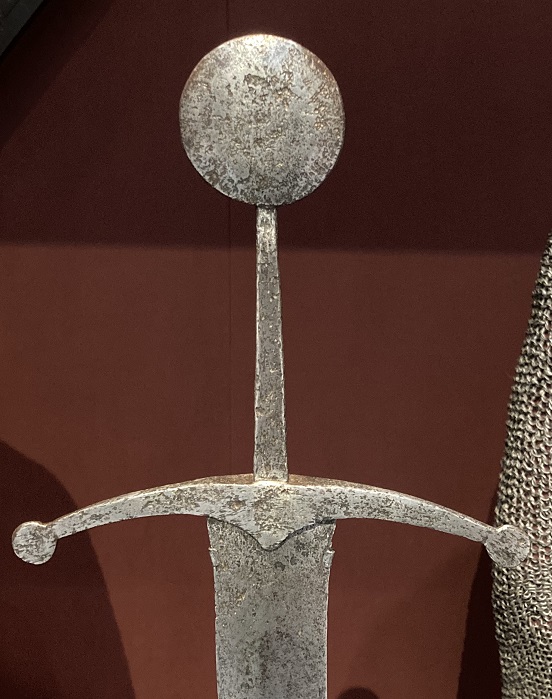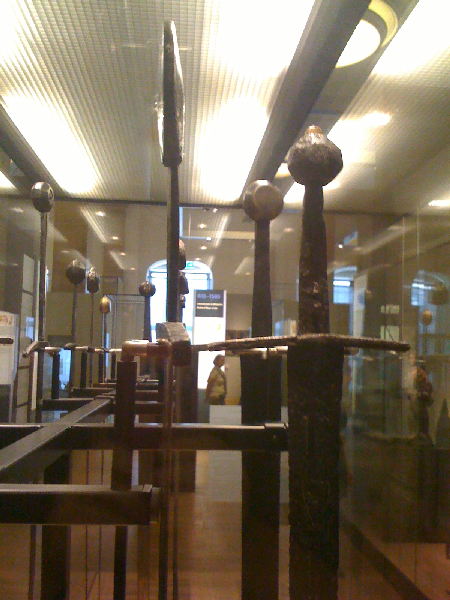| Author |
Message |
Chad Arnow
myArmoury Team


|
 Posted: Thu 03 Feb, 2022 4:19 am Post subject: Odd Cleveland Museum of Art sword Posted: Thu 03 Feb, 2022 4:19 am Post subject: Odd Cleveland Museum of Art sword |
 |
|
I was at the Cleveland Museum of Art yesterday. They have a great collection. One of the items that stood out was a sword dated to the 15th century. It has accession number 1919.69 and you can see the museum's page here:
https://www.clevelandart.org/art/1919.69
What really jumped out is how thin the pommel is when viewed from the side. See my bad phone pics below. Crazy! Anyone know of any other examples that are that thin?
 Attachment: 46.22 KB Attachment: 46.22 KB

 Attachment: 136.84 KB Attachment: 136.84 KB

 Attachment: 86.84 KB Attachment: 86.84 KB


ChadA
http://chadarnow.com/
|
|
    |
 |
Ryan Renfro

|
 Posted: Thu 03 Feb, 2022 6:37 am Post subject: Posted: Thu 03 Feb, 2022 6:37 am Post subject: |
 |
|
|
RA IX.950 (the type XIX Alexandria finger ring sword) is quite similar, about 1.5 cm thick at the middle. It's asymmetrically lenticular when viewed from the top and similar to this one when viewed from the side, although it's at least twice as thick at the grip as it is at the peen. The Cleveland example appears quite thin at the grip end as well. I wonder what the original grip looked like to match it as it must have been really thin where it met the pommel.
|
|
  |
 |
|
Gregg Sobocinski
|
 Posted: Fri 04 Feb, 2022 4:28 pm Post subject: Posted: Fri 04 Feb, 2022 4:28 pm Post subject: |
 |
|
|
Is it solid? I wonder how much the thin pommel weighs compared to a typical hollow one. Anyone know?
|
|
  |
 |
Eric Sherwin

|
 Posted: Tue 22 Feb, 2022 5:53 am Post subject: Posted: Tue 22 Feb, 2022 5:53 am Post subject: |
 |
|
|
I visited the Deutsches Historisches Museum in Berlin several years ago and I remember coming upon a sword with a very similar flat pommel. I was surprised by its thin cross section in relation to its diameter. If I can manage it, I'll download some photos.
|
|
  |
 |
Chad Arnow
myArmoury Team


|
 Posted: Tue 22 Feb, 2022 6:28 am Post subject: Posted: Tue 22 Feb, 2022 6:28 am Post subject: |
 |
|
| Gregg Sobocinski wrote: | | Is it solid? I wonder how much the thin pommel weighs compared to a typical hollow one. Anyone know? |
Not sure. However, I'm not sure "typical" pommels were hollow. Some were, of course, but I'm not aware of info that says the practice was typical. Do you have any sources I can check out on that?

ChadA
http://chadarnow.com/
|
|
    |
 |
Eric Sherwin

|
 Posted: Wed 23 Feb, 2022 12:13 pm Post subject: Posted: Wed 23 Feb, 2022 12:13 pm Post subject: |
 |
|
I finally found the pictures I said I would post. I really enjoyed that museum[/img]
 Attachment: 427.11 KB Attachment: 427.11 KB

 Attachment: 442.94 KB Attachment: 442.94 KB

 Attachment: 445.18 KB Attachment: 445.18 KB

|
|
  |
 |
|
Gregg Sobocinski
|
 Posted: Wed 23 Feb, 2022 5:02 pm Post subject: Posted: Wed 23 Feb, 2022 5:02 pm Post subject: |
 |
|
My mistake, Chad. A quick search of the references I ‘remembered’ indicate “many were hollow” and were “more common than we think”, but not necessarily common. I did intend my comment to be specific to the disc pommels, and not pommels in general.
Edit: I found a video from 2017 where Matt Easton says that the “larger globe and disc pommels were often hollow”. I can imagine my brain hyper- focused on that. He offers a wide variety of examples.
While heading down that rabbit hole, I found an excellent article describing how early medieval hollow pommels were made using the lost wax technique. I wonder how easy this method is versus forge welding two halves.
https://www.journals.uchicago.edu/doi/full/10.1086/668456
|
|
  |
 |
|
|

